This easy, buttery shortbread cookie recipe comes together quickly. You can use one shortbread recipe to make classic shortbread cookies, or press into a pan to make shortbread fingers.
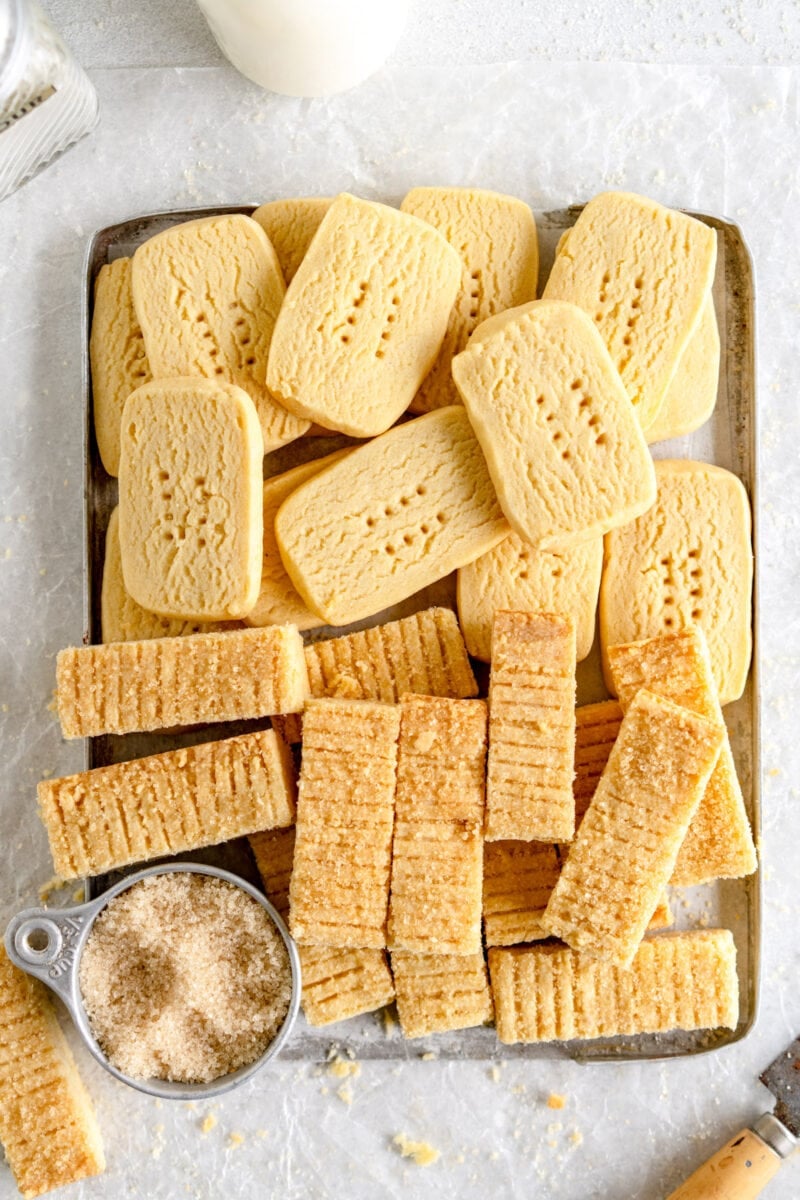
Hi hi! Just jumping in to share this super easy shortbread cookie recipe with you! Shortbread Cookies were one of the very first things I learned to bake from my Grandma, and they are so easy, I can't believe it has taken me this long to get a classic shortbread recipe on my site!
I love making homemade cookie recipes, and this one is extra special to me - to me, these are my ultimate Christmas cookie (or shortbread biscuit as we call them in New Zealand) although they are so good year round too.
Shortbread is a simple cookie to make, and I worked on this dough so that it can be made into two formats - shaped into a log for a slice and bake shortbread cookie, or pressed into a pan and topped with sugar, for more of a Scottish Shortbread style shortbread recipe.
Both options are the perfect shortbread cookie recipe - super buttery, with a nice snap, and a cookie that melts in your mouth. Truly just the best.
I had a bunch of people point out this was a great Ted Lasso shortbread - I haven't seen it, but I had a quick google and it seems to fit perfectly!
The base shortbread cookie recipe does not require a chill time, and can be made in 30 minutes. It is an egg free cookie recipe, made with pretty limited ingredients - it is the best shortbread recipe for a reason!
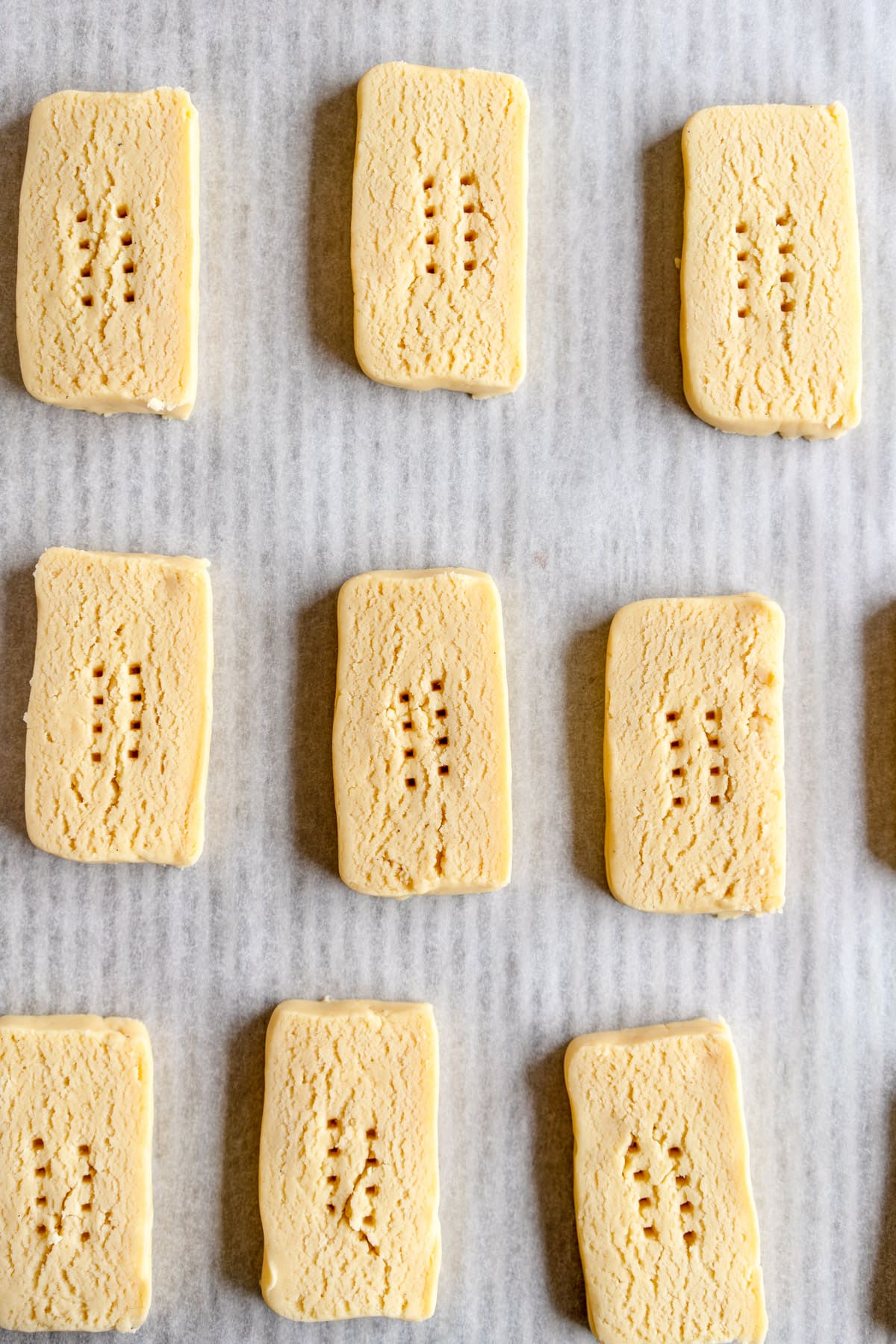
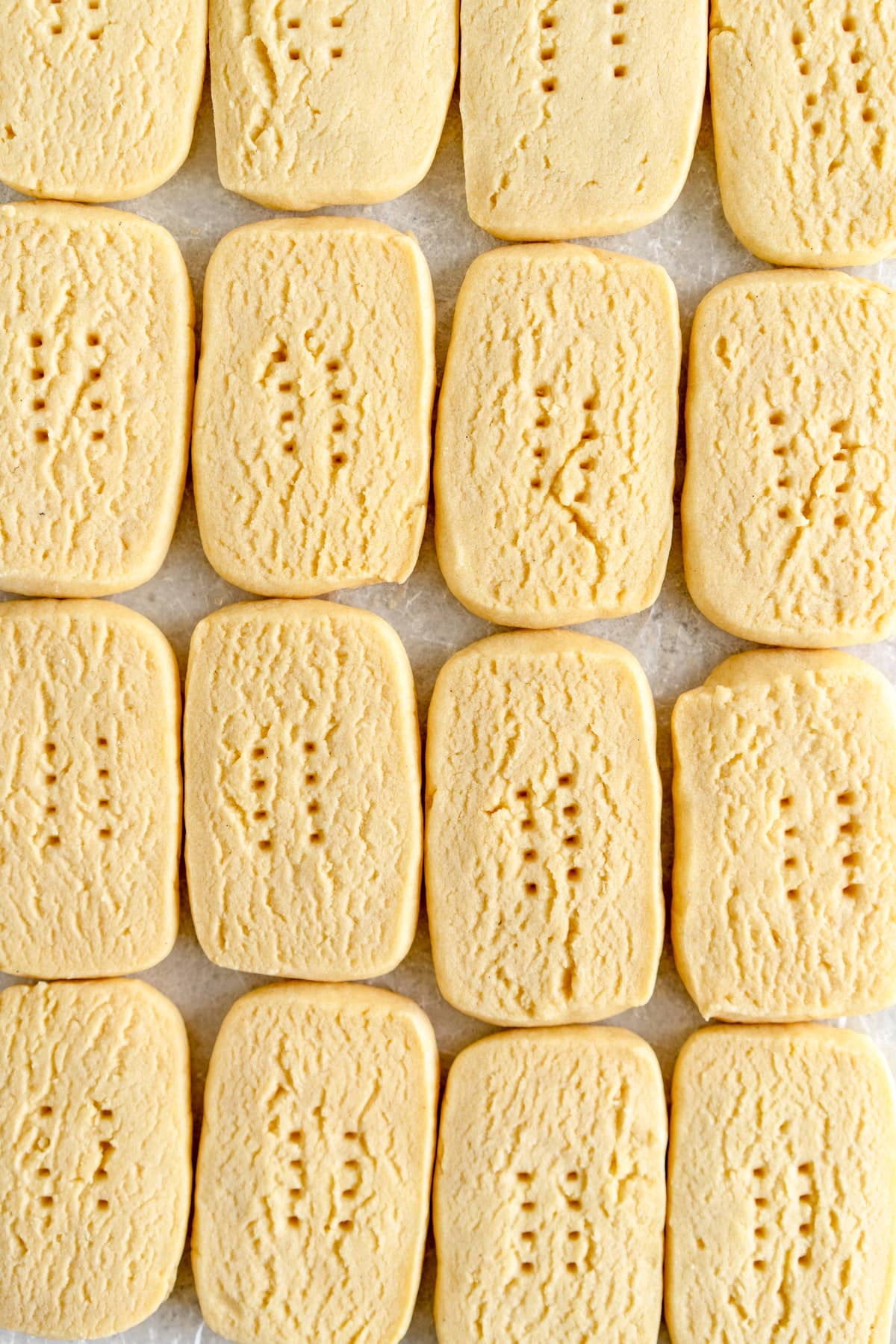
Important Ingredients in Shortbread Cookies
This recipe for shortbread cookies follows a classic 3:2:1 shortbread recipe model: 3 parts flour, 2 parts butter, 1 part sugar, by weight.
This is a classic ratio, and makes the recipe super easy to scale, especially as this is an egg-free cookie recipe.
The dough comes together super quickly, so it is great to double up on and make extra shortbread cookies to have on hand whenever you need - they keep up to two weeks in an airtight container at room temperature.
- Powdered Sugar. Also known as icing sugar - I like to use powdered sugar rather than granulated sugar or caster sugar as it gives the shortbread a super smooth, crumbly finish.
- Butter. This shortbread recipe has minimal ingredients, so good quality butter is important here. I use unsalted, but if you would like to use salted butter, just omit the extra salt in the recipe.
- Flour. All-purpose flour is the best to use for shortbread. I top my flour up with a little cornstarch, which helps give the shortbread cookie a tender finish. You can use custard powder if you have that on hand in the place of the corn starch.
- Vanilla. This is optional and not often included in traditional shortbread recipes, but I love the flavour profile that it adds.
That's it! This shortbread recipe is super super simple - I really hope you love it as much as I do.
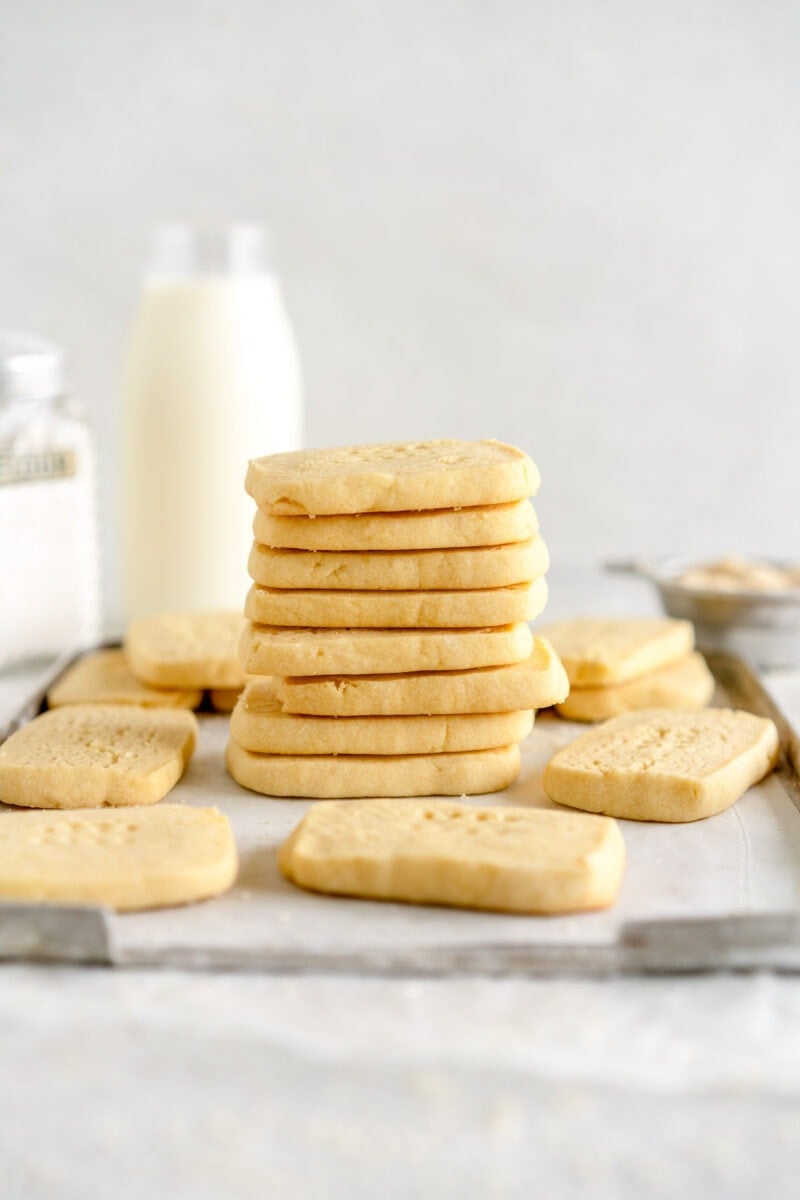
Two Shortbread formats - slice and bake shortbread, and Scottish shortbread
I worked on this dough so that you can use the plain shortbread recipe to make two forms of shortbread - one which you form into a log and slice into pieces, then bake to form shortbread cookies, and one where you press the shortbread dough into a pan, then bake at a lower temperature for a longer period of time, then slice into fingers, like Scottish shortbread.
Both formats are super easy and I truly don't have a favourite between the two of them - if you are wanting to make these in bulk, the scottish shortbread recipe might be easier, however I do love the look of the classic, slightly shaggy shortbread cookie.
You could also press the mixture into a 10" round cake pan and then turn out and cut into shortbread wedges.
The recipe for these shortbread cookies details how to make the slice and bake format - for the Scottish shortbread, check the notes under the recipe for the baking time and temperature.
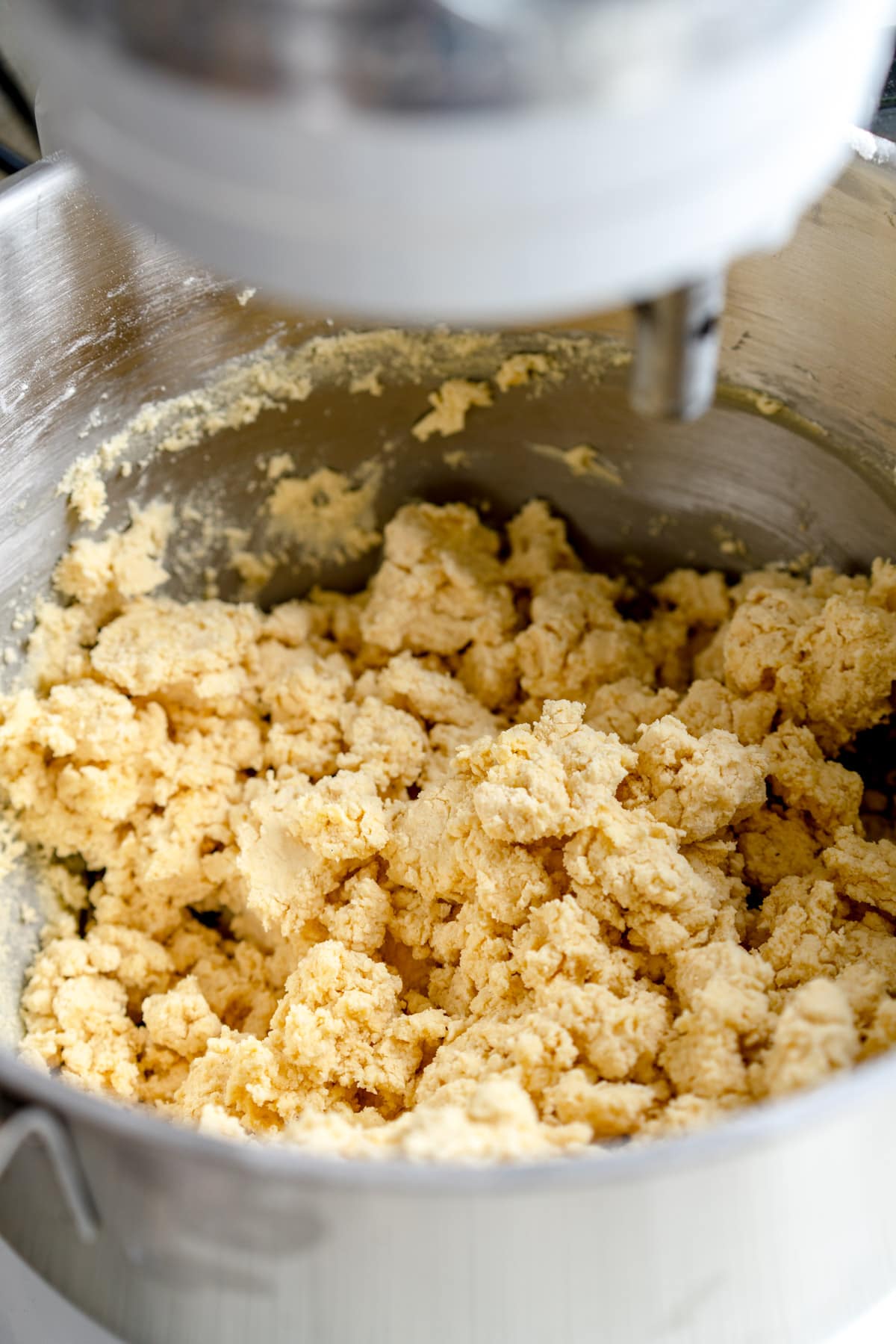
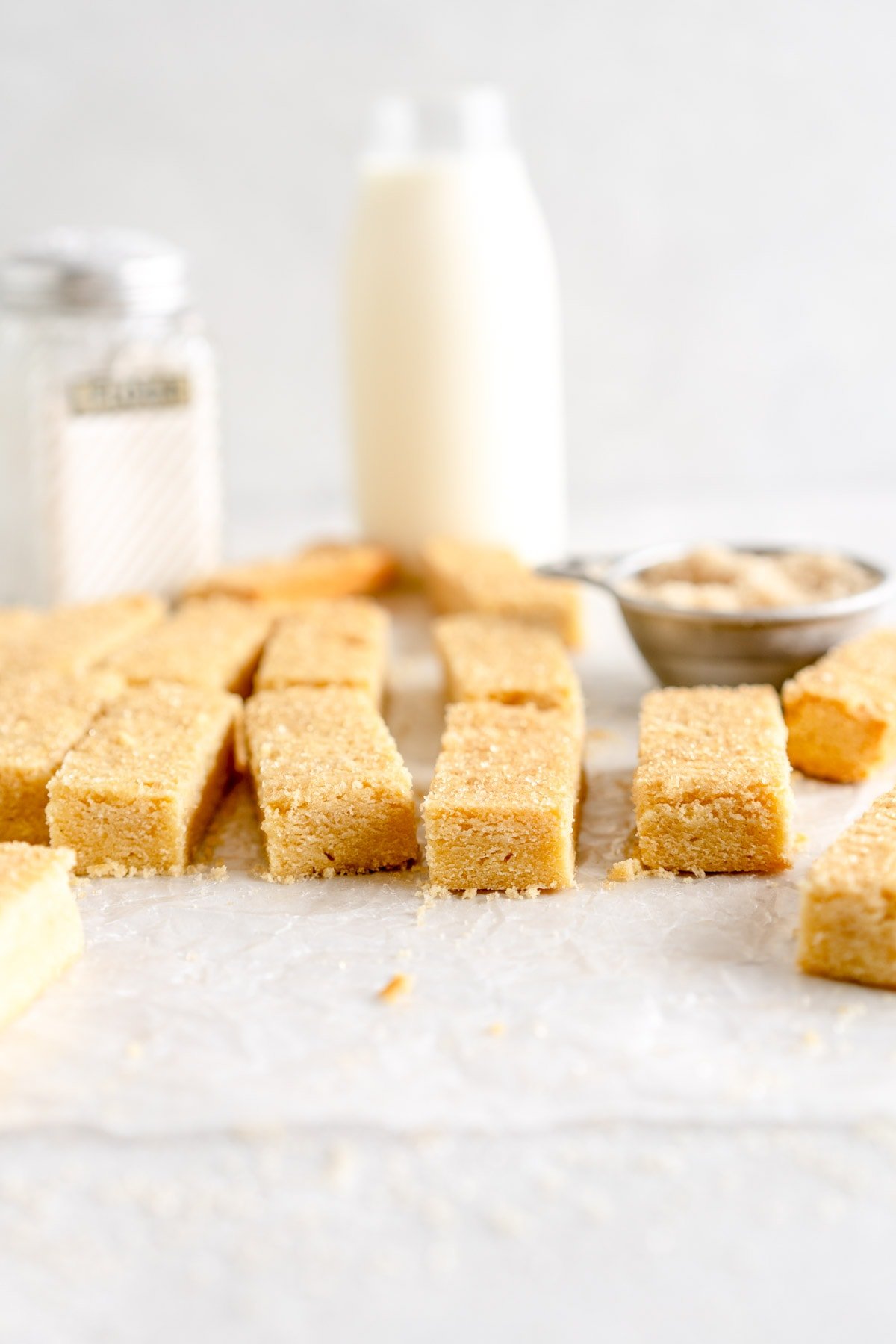
Why the lower oven temperature?
Shortbread cookies are baked at a lower oven temperature than something like a chocolate chip cookie recipe - although it is quite a stiff dough, you do want to prevent it from spreading too much, and you want the cookies to bake before they turn golden.
A good way to check to see if the shortbread is baked is to see if they are set - they will be slightly firm around the outside, and may be just beginning to turn golden around the edges. You want to keep them nice and pale so make sure your oven is running at the temperature it says that it is.
I bake the shortbread cookies at 160°c / 320°f, and the Scottish shortbread at 150°c / 300°f.
Both oven temperatures are conventional, not fan - this is important to ensure that your cookies do not over bake. You will need to adjust your oven if it will only bake with fan.
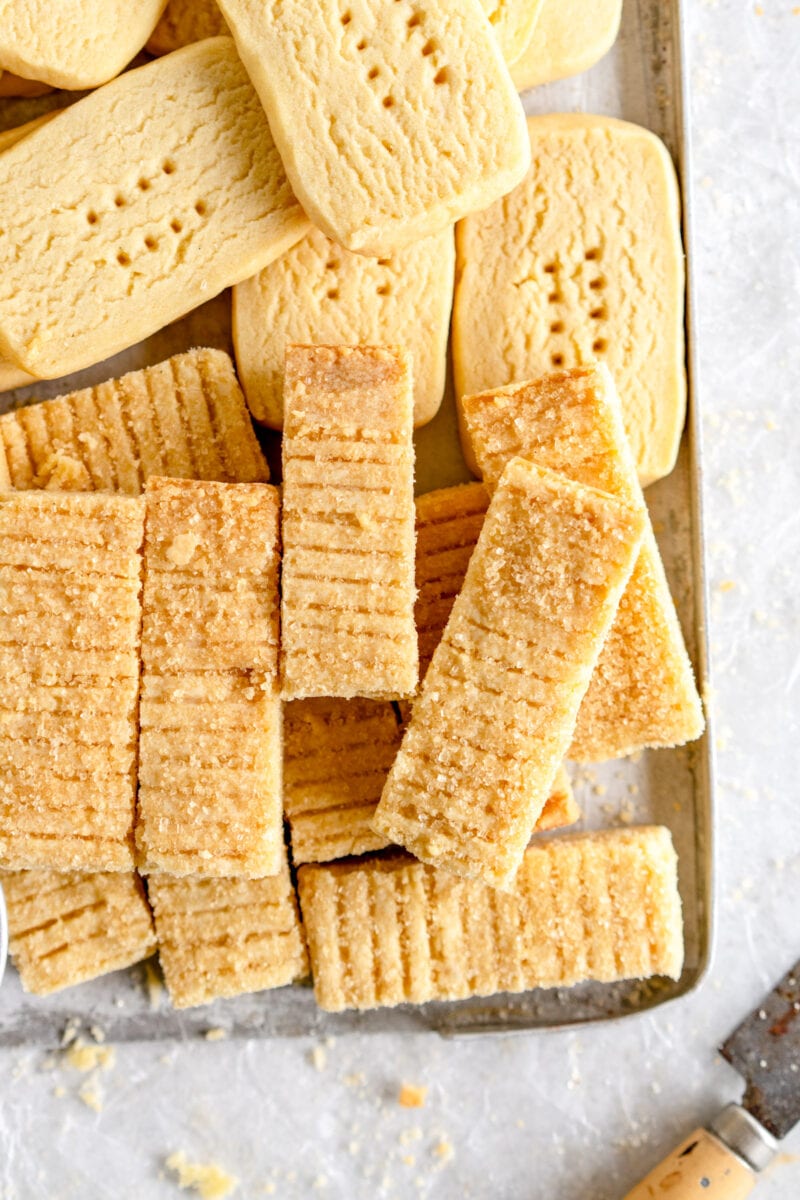
What are the fork holes in shortbread for?
The fork holes in my shortbread are there because my grandma put them there, so now I do too. They do help the cookies from puffing up in the oven I think, but the pattern is totally up to you - my Grandma did two fork holes, so now I do too!
To me, that rustic shaggy look on the top of the shortbread cookies is how I like it - it comes from the dough dragging against the knife.
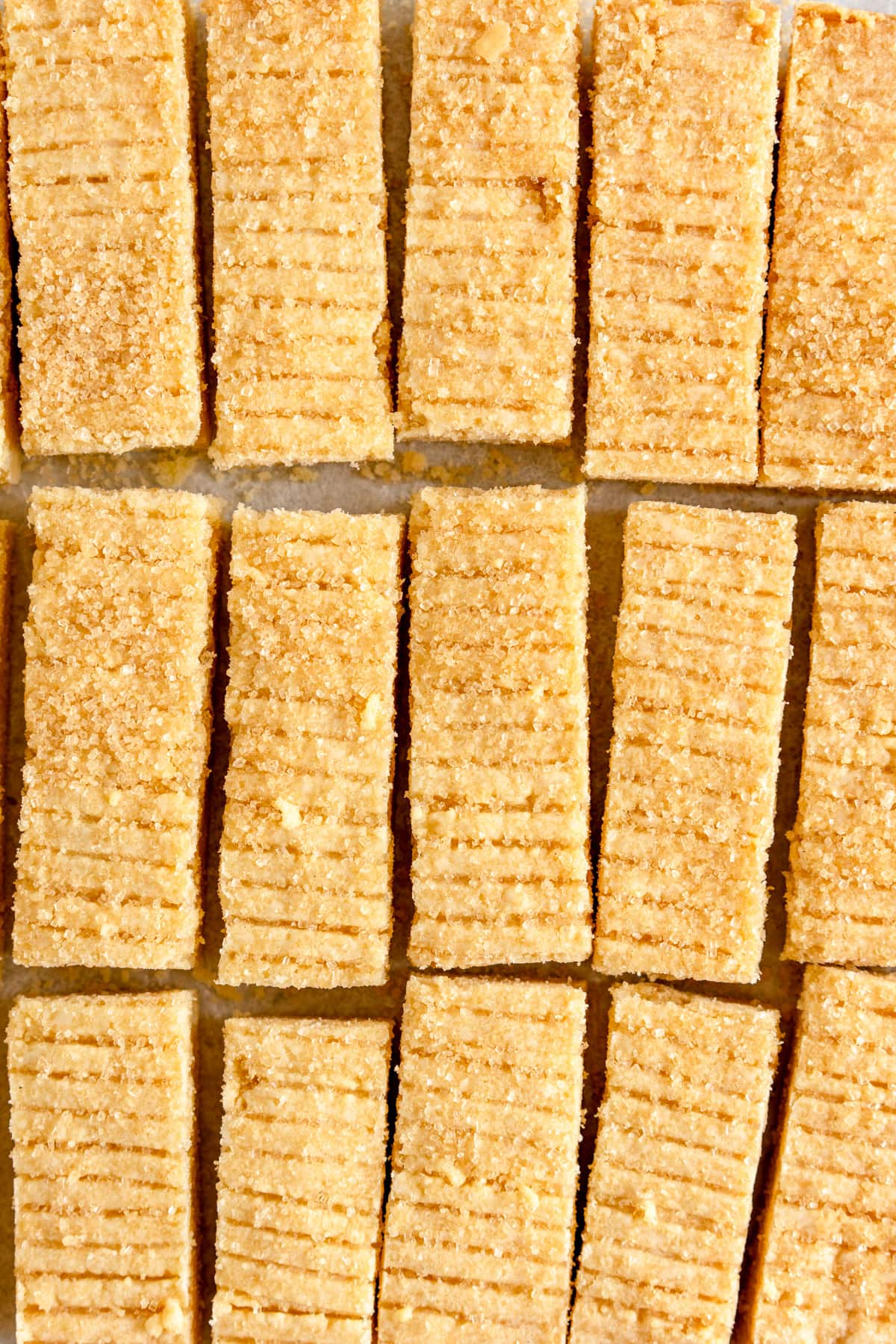
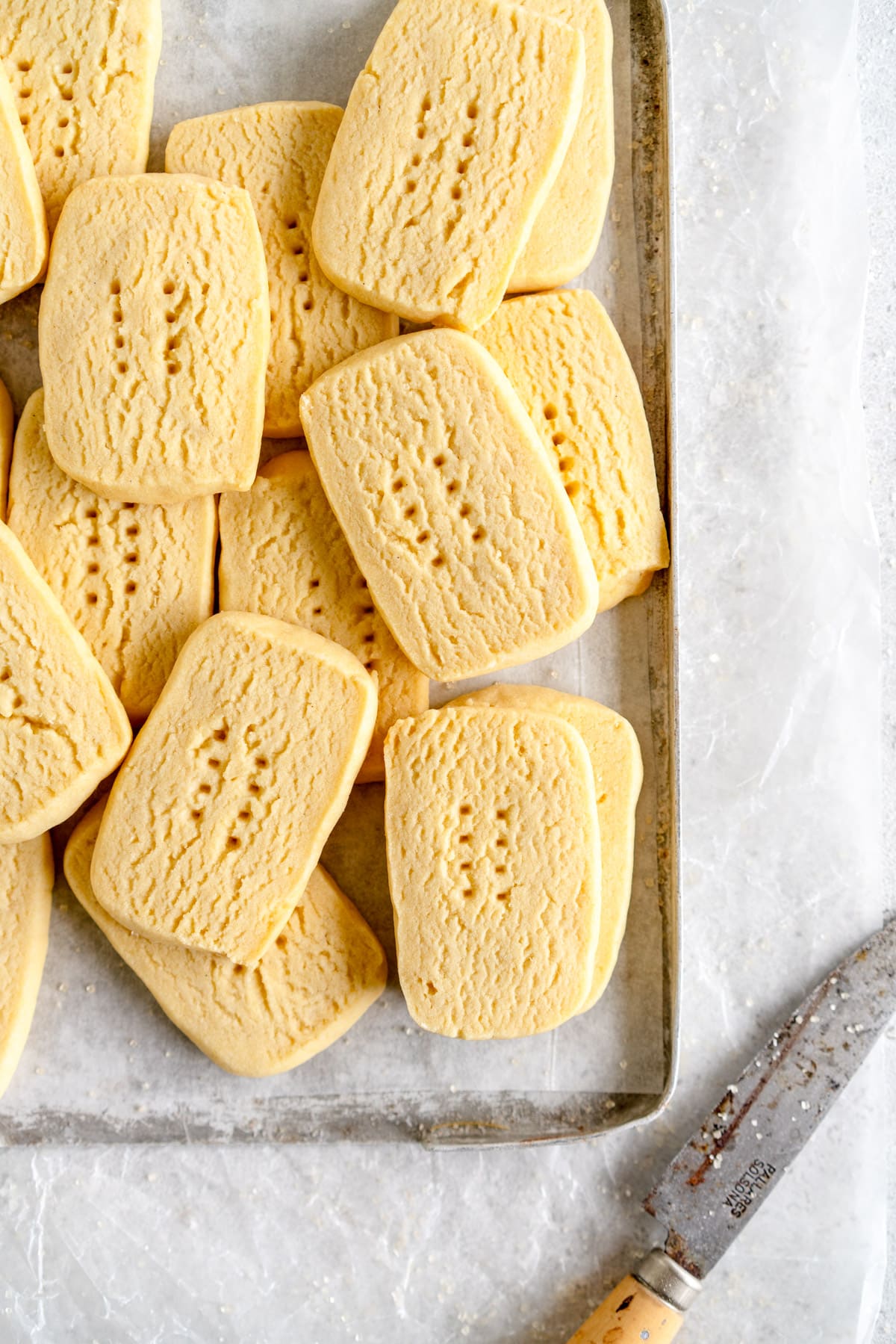
❤️ Made this recipe and love it? ❤️
I would LOVE for you to leave me a review and star rating below to let me know how you liked it! Also, please make sure to tag me on Instagram!
Answers to your baking questions
Over the years, many of you have asked me questions about:
- baking in grams
- adjusting oven temperatures
- what kind of salt to use
- and many more!
I've curated and answered them all for your easy reference in this frequently asked questions post!
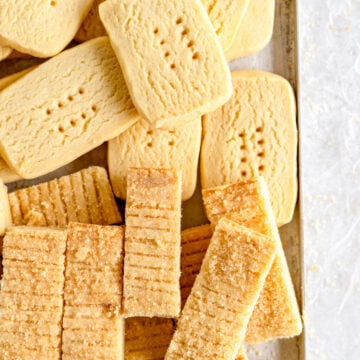
30 Minute Shortbread Cookies
- Prep Time: 10 minutes
- Cook Time: 20 minutes
- Total Time: 30 minutes
- Yield: 32 cookies 1x
- Category: Cookies
- Method: Baking
- Cuisine: English
Description
This easy, buttery shortbread cookie recipe comes together quickly. You can use one shortbread recipe to make classic shortbread cookies, or press into a pan to make Scottish shortbread.
Ingredients
- 125g powdered sugar, sifted
- 250g unsalted butter, at room temperature
- 1 tsp vanilla bean paste or vanilla extract (optional)
- 2g (½ tsp) kosher salt (leave out if using salted butter)
- 350g all-purpose flour
- 30g corn starch
Instructions
- Preheat the oven to 320°f / 160°c. Line two sheet pans with parchment paper.
- In the bowl of a stand mixer fitted with with the paddle attachment, or in a medium bowl using a handheld electric mixer, cream together the powdered sugar, butter, and vanilla until light and creamy, 2-3 minutes. Sift together the flour, corn starch and salt if using and add to the bowl, and mix until just incorporated.
- Turn out the dough onto a work surface, press the dough together, and shape into a rectangle log about 3 ½ cm x 6 cm (1.4"x2.3"), squaring off the edges with a bench scraper.
- Using a sharp knife, cut the shortbread into biscuits 1cm (0.4") thick, and arrange on the trays, leaving a little room for spreading.
- Bake the shortbread for 16 to 17 minutes, until set and just beginning to turn golden around the edges. Remove from the oven and leave to cool on the pans, then transfer to a wire rack.
- Store shortbread in an airtight container at room temperature for up to two weeks - best eaten the week that they are made.
Notes
For Scottish shortbread : Preheat the oven to 300°f / 150°c bake. Grease and line a 9" (23cm) square pan with parchment paper, extending it over the edges to form a sling.
Make the dough as directed, then press the mixture into the prepared pan, smoothing down with your hands. Prick with a fork or make a design on the top. Sprinkle with raw sugar if you like, then bake for 50 to 55 minutes until lightly golden. Remove from the oven, leave to cool, then remove from the pan and slice into fingers using a sharp knife.
If you wanted to make shortbread ahead of time, you could freeze the baked cookies in an airtight container for up to a month, then defrost at room temperature. They are definitely much better fresh though, so if you can, make them ahead! For more information on freezing cookies, check out my post on how to freeze cookie dough
To make roll-out shortbread cookies, make the dough as usual, then turn out onto a piece of parchment paper. Shape into a rough rectangle, I like to fold the edges of the paper over to help bring the dough together. Top with another piece of parchment paper. Roll to 6mm thickness (I used rolling pin guides), to about the size of a half sheet of parchment paper.
Keeping the dough between the two pieces of parchment paper, transfer to a sheet pan and chill for at least 2 hours and up to 3 days. Cut out shapes of your choice, then return the cookies to the freezer for 10-15 minutes. Bake at 165°c / 325°f for 12-13 minutes until lightly golden brown around the edges. Leave to cool on the pan. I have used this pretzel cookie cutter, and snowflake plunger cutters also work.

Comments
Helen Kornaraki says
This is an amazing recipe! I make the cookies every Christmas and I also gift them to family. They keep asking for more! I follow the recipe to the letter but they always seem a bit crumbly and fall apart as I cut them for baking. Why would this be happening? I'd love it if you could help!
Erin Clarkson says
Hi! Are you making the recipe by weight? Also some brands of flour are more thirsty than others so you could try a tiny bit less flour and see if that helps? Otherwise just make sure that they are really well smushed together into a log!
Helen Kornaraki says
Thank you for your reply! I'll try that next time!
Nigel Thompson says
Found this recipe was not as good as my regular, mixture seemed to have two much flour even when I measured exactly the weights, tasted to heavy I would rather use corn flour than regular all purpose flour for a lighter texture
Erin Clarkson says
Sorry they didn't work out for you!
Natalie says
Delish. These make for such an easy gift, I decorate mine with royal icing 🤪
Erin Clarkson says
Hahahahha these are AMAZING!